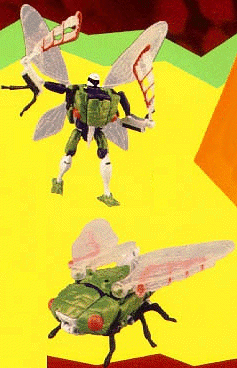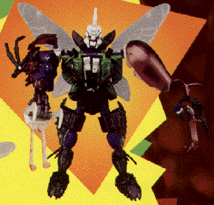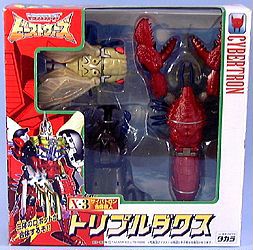 BEAST WARS : TOY
REVIEW
BEAST WARS : TOY
REVIEW
Names: Cicadacon, Ram Horn, Sea Clamp (unite to form TRIPREDACUS)
Allegiance: Predacon
Function: Battle Master
Beast Modes: Cicada, Stag Beetle, Lobster
Average Price: 45 AUD
CICADACON:

BEAST MODE
The colour scheme of this mode is primarily green with some
white and purple accents. Vermillion is used for the eyes and accents the
two larger wings. The wings themselves are a dulled transparent white.
The wings are connected to the body via ball joints, allowing greater articulation
for the wings. The wings extend to a maximum wingspan of 21 centimetres.
The also remain nice and stiff, instead of getting all floppy like Waspinator's.
The legs are dark brown and unlike some other insectoid Transformers, are
able to fully support the body weight (rather than flopping down on its
belly). This is partly due to the absence of any knee joints. The only
drawback to this mode is that the robot arms and legs stick out from behind.
Tripredacus' face is also clearly visible from underneath.
TRANSFORMATION TO ROBOT MODE
Remove the vermillion accented sabres from beneath the larger
wings. Fold robot arms out to the sides. Flip down the entire insect head
(all three sections) - forming robot chest. Flip out back hatch and flip
out robot head - close the hatch. Open out the green side panels and fold
down robot legs. Close side panels. Position wings and limbs and place
sabres into robot fists.
ROBOT MODE
Standing at around 11.5cm, Cicadacon is about as tall as
most Basic sized figures. The body, thighs and feet are green. There are
purple accents throughout the torso and the upper arms, waist and knees
are also purple. The forearms, lower legs and head are white. The face
is purple with vermillion eyes. This is a very nice looking robot mode.
It's the most anthropomorphic (humanoid) of all the Tripredacus robots
and is also the most slender. The insect wings suit the robot mode quite
well and the insect legs are short enough so they're not irritating during
play. Cicadacon has 15 points of articulation in this mode. The robot head
looks like they were going to put in a light piping gimmick to make the
eyes glow, but for reasons unknown to me, they abandoned it in plugged
up the would be entry port for light with a green piece of plastic.
RUB STICKER LOCATION
Behind robot head.
RAM HORN:

BEAST MODE
Ram Horn is a metallic brown rhinoceros beetle. The eyes
are green and the legs are dark brown. The sculpting is pretty descent,
with the only major robot part exposed being the robot shoulders.
Ram Horn measures about 14cm in length.
TRANSFORMATION TO ROBOT MODE
Ram Horn has the most complex and difficult transformation
scheme among the Tripredacus robots. Flip up the abdomenal shell and take
out the weapon inside. Divide the thorax in half. Fold out rear insect
legs, forming robot legs. Twist the main body around, forming the back
of the robot. Bring the thorax halves down and close them to form robot
chest. Open insect head to reveal robot head.
ROBOT MODE
In robot mode, Ram Horn retains the metallic brown colour
from the beast mode, however, it is now accompanied by several purple (mainly
robot) parts. The face is white and the eyes are yellow with purple eyeballs.
The lower jaw and parts of the head are also purple. The weirdest thing
about Ram Horn's robot mode is the sculpting of the face. It's bizzare!
The two eyeballs are crossed, staring at each other. The jaw also opens
and closes, exposing teeth. However, it looks more like he's smiling than
growling. THe facial mould is about as menacing and evil as fairy floss.
I think it's much more suited to his Maximal repaint, Motorarm (see below).
This toy has 14 points of articulation and stands at 15.5 centimetres in
this mode, making it the tallest among all Tripredacus robots (save Tripredacus
himself, of course) - this is due to the huge horn on top of the head.
RUB STICKER LOCATION
Inside the rear shell section.
SEA CLAMP:

BEAST MODE
Sea Clamp is the only Tripredacus robot who transforms into
a crustacean rather than an insect. Yep, nothing escapes me. The toy is
16cm in length from the tip of the tail to the tip of the haed ("nose").
The toy is covered with crustacean-like bumps and ridges and is coloured
translucent purple-brown with purple accents. This makes Sea Clamp look
like a live lobster, whereas his Maximal counterpart, Gimlet, who looks
like a cooked lobster. The legs and antennae (which I think was a nice
touch) are dark brown. The eyes are green.
TRANSFORMATION TO ROBOT MODE
Reposition the underside of the tail to form robot feet.
Separate lobster head and fold them out to the sides to form robot shoulders.
Position claws to form robot arms. Turn waist 180 degrees. Fold down robot
chest, flip up robot head and close chest. Open claws and extend serrated
claw weapons. The crustacean like moulding dominates this mode's form,
however, I think it blends in rather well with the robot components. Like
Ram Horn, more purple robot parts are visible in this mode. Sea Clamp is
only half a centimetre taller than Cicadacon.
ROBOT MODE
A very impressive robot mode. The oversized arms give a look
of power and with
TRIPREDACUS:

UNITE!
Ramhorn's rear shell, arms and legs all split to form an
arm each. The centre slide bar which connects them to each other connects
into a section of Cicadacon. The part of Tripredacus' arm formed by Ramhorn's
arms grip his weapon and can act as opposable digits themselves.
Cicadacon's robot head folds back in. Ramhorn connects
into the area where his head rests. The back panel moves over the bar which
connects Ramhorn's two halves. Tripredacus' head folds up to hold the arms
firmly in place. Cicadacon's legs fold up to the back and the hips split
apart.
Sea Clamp's mid section folds back and the claws split
wide apart, forming robot feet. The lobster halves split as well, forming
lower body and legs.
Cicadacon's hip joints then "pinch" onto Sea Clamp's
mid-section joint.
Sea Clamp's launcher, Ram Horn's blades and Cicadacon's
sabres all combine to form a slashing missile launcher.
GESTALT MODE
A rather impressive gestalt, I must say. It's a lot better
than what I expected. The head is fierce and menacing, portraying a vicious
snarl. Ram Horn's shell parts look great as shoulder pads and although
the toy lacks traditional robot fists, it does have fully opposable digits!
They don't look humanoid at all, though, but I don't mind. The large feet
give this toy great stability. This toy has 11 points of articulation and
stands at 18 centimetres (not including antenna).
OVERALL
A very nice toy. My favourite among the first wave of Beast
Wars gestalts (the other being Magnaboss).
TRIPLEDUX

In Japan, Tripredacus was repainted into the Cybertron
(Maximal) gestalt, Tripledux.
Tripledux is comprised of the Jointron Brothers, who
are:


 (L to R): DJ, Motorarm and Gimlet!
The Jointron brothers were sold separately and together as
Tripledux:
(L to R): DJ, Motorarm and Gimlet!
The Jointron brothers were sold separately and together as
Tripledux:
 Tripledux's transformation scheme also varied slightly from
Tripredacus'. Rather than leaving the lobster tail hanging, it is inverted
upwards and forms part of the robot's back.
Tripledux's transformation scheme also varied slightly from
Tripredacus'. Rather than leaving the lobster tail hanging, it is inverted
upwards and forms part of the robot's back.
Muy bueno!
BEAST TRIVIA
Cicada
Any medium to large (two to five centimetres) insects of the order Homoptera,
with two pairs of membranous wings, prominent compound eyes and three simple
eyes (ocelli). Most of the species belong to the family Cicadidne, but
the family Tettigaretidae consists of two species of hairy cicadas found
only in Southeastern Australia, including Tasmania. Male cicadas produce
loud noises by vibrating membranes (timbals) near the base of the abdomen.
Most North American cicadas produce rhythmical ticks, buzzes or whines,
although in some species, the song is "musical." Eggs are usually laid
in woody tissues; newly hatched nymphs burrow into the ground where they
suck juices from perennial plants. Nymphs usually undergo five molts during
the several years required to reach maturity. Although not ordinarily considered
a pest, the females, if numerous, may damage young saplings during their
egg laying.
There are around 1500 known speciesm of Cicada. Cicadacon/DJ's beast
mode resembles Tibicen pruinosa, which are tropical and occur in
deserts, grasslands and forests. The male of each species have three distinct
sound responses: a congregational song that is regulated by daily weather
fluctuations and by songs produced by other males; a courtship song, usually
performed prior to copulation (a serenade followed by a night of passion,
this is insect romance at it's best!) and a disturbance squawk produced
by individuals captured, held or disturbed into flight.
Cicadas have been used in holistic medicines, as religious and monetary
symbols, and as an important source of food. Their song was once considered
to forecast weather changes. The male cicadas were caged for their songs
in China. The cicada appears in the mythology, literature and music of
many cultures.
| Click
here for more information and images on cicadas |
Lobster
Marine crustaceans of the order Decapoda and comprising of the families
Homaridae (or Nephrosidae), true lobsters (Palinuridae), spiny lobsters
/ crayfish (Scyllaridae), slipper, Spanish and shovel lobsters, and deep
sea lobsters (Polychelidae). All are marine and benthic (bottom dwelling).
Mainly nocturnal, they scavenge for dead animals but also eat live fish,
other animals and seaweed. Some species, especially of true and spiny lobsters,
are commercially important.
The lobster has a rigid, segmented body exoskeleton and five pairs of
legs. One or more pairs are often modified into pincers (chelae) with the
chela on one side usually larger than the other. The eyes are moveable
stalks and there are two pairs of long antennae. Several pairs of simming
legs (swimmerets) are on the elongated abdomen. A flipper-like tail is
used for swimming. Flexing the tail and abdomen propel the animal backward.
The true lobster have claws on the first three pairs of legs, with very
large claws on the first pair. They have a distinct rostrum, or snout,
on the carapace, which covers the head and thorax.
The American lobster (Homarus americanus) and the Norway lobster
(Nephrops norvegicus, or Dublin Bay prawn/scampi) are the most valuable
and often marketed alive. The heavily muscled abdomen and claws are the
parts eaten. True lobsters are found in all but polar sea and the greater
depths. The European lobster (Homarus gammarus), a dark greenish
animal, occurs on the rocky bottoms of the European Atlantic coast and
the Mediterranean Sea. Homarus capensis, of the waters around South
Africa, grows to 10 or 13 centimetres and is of little commercial value.
Lobsters caught in shallow water weight about 0.45 kg and are often
about 25 cm long. They are caught usually in lobster pots - cages baited
with dead fish. In deeper water, they weight about 2.5 kg and are often
caught by trawling. Exceptionally large specimens may weigh 20 kg.
Females are ready to lay eggs when about five years old. Sperm are transferred
from males to females in summer, but fertilisation does not occur until
spring. A female lays 3000 or more eggs, which remain attached to her swimmerets
until they hatch several months later. Unlike adults, they young, about
1 cm long, swim freely for about 12 days an then descend to the bottom.
Some lobsters may live up to 50 years. Young lobsters are preyed upon especially
by dogfish, skates and cod. The principal enemy of the adult lobster is
man.
The red colour of lobsters is caused by immersion in hot water.
| Click
here to learn about laws concerning lobster fishing |
Rhinocerous Beetle
Members of the Dynastes and Oryctes genuses of the sub-family
Dynastinae, which itself is a sub-family of Scarabaeidae
(order Coleoptera). They are closely related to the unicorn and elephant
beetles. Horn-like structures on the thorax and head of the male (usually
lacking in females) make it conspicuous. Both males and females have horns.
(so I guess this means Ram Horn/Motorarm transforms into a female
rhinocerous beetle!)
Known as Kabutomushi ("helmet-bug") in Japanese due to the insect
head's resemblance to a Samurai war helmet.
| Click
here for an image of a male rhinoceros beetle | Click
here for an image of a female rhinocerous beetle |
Bibliography: Encyclopaedia Brittanica
E-mail
Back
 BEAST WARS : TOY
REVIEW
BEAST WARS : TOY
REVIEW







